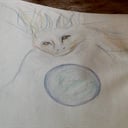What do adult Luna moths eat?
The Luna moth (Actias luna) is a Nearctic moth in the family Saturniidae, subfamily Saturniinae, a group commonly known as giant silk moths. It has lime-green colored wings and a white body. The larvae (caterpillars) are also green. Typically, it has a wingspan of roughly 114 mm (4.5 in), but can exceed 178 mm (7.0 in), making it one of the larger moths in North America.
The Luna moth is indigenous to North America, from east of the Great Plains in the United States – Florida to Maine, and from Saskatchewan eastward through central Quebec to Nova Scotia, in Canada. They are also rarely found in Western Europe as vagrants.
Across Canada, it has one generation per year, with the winged adults appearing in late May or early June, whereas farther south it will have two or even three generations per year, the first appearance as early as March in southern parts of the United States.
The larvae of Luna moths feed on several different species of broadleaf trees including white birch, American persimmon and American sweet gum, plus several species of hickory, walnut and sumac.
Adults have only vestigial mouth parts and do not feed. Energy is from fat stores created while a caterpillar. The lifespan of adult Luna moths is only about 7 days.
The Luna moth appeared on a first class United States postage stamp issued in June 1987. Although more than two dozen butterflies have been so honored, as of February 2020, this is the only moth.
More Info:
en.wikipedia.org










